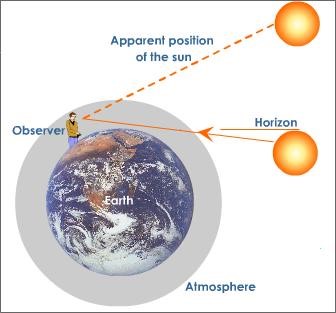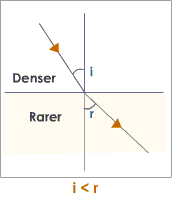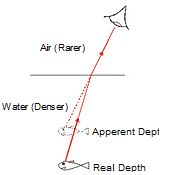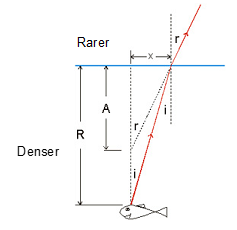It is a matter of common experience that a swimming pool appears to have less depth than its actual depth. Similarly a straight stick partly immersed in water appears to be bent at the surface of water. The above observations suggest that light changes its path as it passes from one medium to another. This change in the path of light is due to the fact that the velocity of light varies as it travels from one medium to another. Thus the deviation in the path of light when it passes from one medium to another medium of different density is called refraction.

Apparent Star Position due to Atmospheric Refraction
The twinkling of stars is due to atmospheric refraction of starlight. Since the atmosphere bends starlight towards the normal the apparent position of the star is slightly different from its actual position. We have observed that the sun is visible at the horizon about 2 minutes before the actual sunrise, and about 2 minutes after the actual sunset. This is also because of atmospheric refraction.

Refraction of Light
Let us now see what happens when a ray of light is incident on the boundary separating the two mediums having different densities.
A part of the light gets reflected and rest of the light changes its direction as it enters the second medium.

IO incident ray, OR refracted ray
The diagram shows how the light gets refracted when it is traveling from one optical medium to another. Like reflection, refraction of light takes place according to certain laws. Before we state these laws let us get familiar with certain terms which are commonly used to explain the phenomenon of refraction.
Also Check: Thrust & Pressure
Incident Ray: The ray of light striking the surface of separation of the mediums through which it is traveling is known as the incident ray.
Point of Incidence: The point at which the incident ray strikes the surface of separation of the two mediums is called the point of incidence.
Normal: The perpendicular drawn to the surface of separation at the point of incidence is called the normal.
Refracted Ray: The ray of light which travels into the second medium, when the incident ray strikes the surface of separation between the mediums 1 and 2, is called the refracted ray.
Angle of Incidence (i): The angle which the incident ray makes with the normal at the point of incidence, is called angle of incidence.
Angle of Refraction (r): The angle which the refracted ray makes with the normal at the point of incidence is called angle of refraction.
Cause of Refraction
A ray of light refracts or deviates from its original path as it passes from one optical medium to another because the speed of light changes.
Snell’s Law of Refraction
- The incident ray, the refracted ray and the normal to the surface at the point of incidence all lie in one plane.
- When a light travels from denser to rarer medium it bends away for normal and vice versa. For any two given pair of mediums, the ratio of the sine of the angle of incidence to the sine of the angle of refraction is a constant for the pair of medium.
The above law is called Snell's law after the scientist Willebrod Snellius who first formulated it
Thus Sin i /Sin r = a constant = µ
Also Check: Light
Where µ is the refractive index of the second medium with respect to the first medium.
We know that the phenomenon of refraction is taking place because the speed of light changes when it is traveling from one optical medium to another.
Thus we can define refractive index in terms of the speed of light in the two media.
The refractive index of glass with respect to air is given by the relation.

Refraction of Light
airµglass = speed of light in air / speed of light in glass
In general, if a ray of light is passing from medium 1 to medium 2, then
1µ2 = speed of light in medium 1 / speed of light in medium 2
If the medium 1 is air or vacuum, the refractive index of medium 2 is referred to as the absolute refractive index.
The refractive index of a medium depends on the following factors:
- the nature of the medium
- the color or wave length of the incident light
Also Check: Sound
Ques 1: Find the refractive index of glass if the speed of light in glass in 2 × 108 m/s. (Speed of light in air is 3 × 108 m/s)
Solution: airµglass = speed of light in air / speed of light in glass
= 3 x 108 / 2x 108 = 1.5
Real and Apparent Depth
To an observer standing at the side of a swimming pool, objects under the water appear to be nearer the surface than they really are. A similar effect can be seen when "looking through" glass or any other transparent substance.
A fish appears to be nearer the surface than it really is:

A straight stick appears to be bent when part in and part out of water:

Both these effects are caused by refraction of light at the surface of the water. Therefore the magnitude of the effect is related to the refractive index of the media involved.
Also Check: Waves
If object is in denser medium and it is being seen from rarer medium then rays coming from object will deviates away from normal in the observer’s medium (rarer) so apparent distance of object seem less than the real distance for the observer. We could understand in better way from the following ray diagram.

As light rays is moving from denser to rarer medium, r > i, therefore shift is upwards
Frequently Asked Questions
Refraction is the bending of a wave when it moves from one medium to another.
Refraction of light happens when a light wave moves from one material into another and changes speed.
Refraction doesn't happen when light hits a boundary straight on, without any angle.
Reflection is when light bounces off a surface, while refraction is when light changes direction as it passes through different materials.
A rainbow is an example of refraction, where light bends as it goes through water droplets in the air.
Twinkling stars and rainbows are examples of refraction in daily life.
Reflection is when light bounces off a surface. Refraction is when light changes direction as it passes from one material to another.
The refractive index measures how much a light ray bends when it moves from one material to another. It's the ratio of light's speed in a vacuum to its speed in a material, represented as n = c/v.
Dispersion is when white light separates into different colors (violet, indigo, blue, green, yellow, orange, and red) as it passes through a prism.
Related Links
| S.no | Formulas List |
|---|---|
| 1. | Force |
| 2. | Frictional Force |
| 3. | Thrust and Pressure |
| 4. | Buoyant Force |
| 5. | Waves |
| 6. | Sound |
| 7. | Some Natural Phenomena |
| 8. | Electroscope |
| 9. | Lightning |
| 10. | Earthquake |